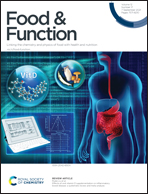Investigation into the mechanisms of quercetin-3-O-glucuronide inhibiting α-glucosidase activity and non-enzymatic glycation by spectroscopy and molecular docking
Abstract
The inhibition of α-glucosidase and glycation is closely related to the treatment of type 2 diabetes mellitus (DM) and its complications. In this study, quercetin-3-O-glucuronide (Q3GA) showed reversible and mixed-mode inhibition of α-glucosidase activity, with an IC50 value of 108.11 ± 4.61 μM. This was mainly due to the spontaneous formation of Q3GA–α-glucosidase driven by hydrogen bonding and van der Waals forces, which could change the microenvironments and conformation of α-glucosidase. In addition, Q3GA showed strong suppression of the formation of glycation products, including fructosamine, advanced glycation end products (AGEs), and 5-hydroxymethylfurfural (5-HMF). Molecular docking analysis demonstrated that Q3GA entered the hydrophobic pocket of ovalbumin to form six hydrogen bonds with amino acid residues, which affected the glycation process. These findings indicate that Q3GA is an excellent inhibitor of α-glucosidase and glycation, and promote its development as a drug or dietary supplement for DM.



 Please wait while we load your content...
Please wait while we load your content...